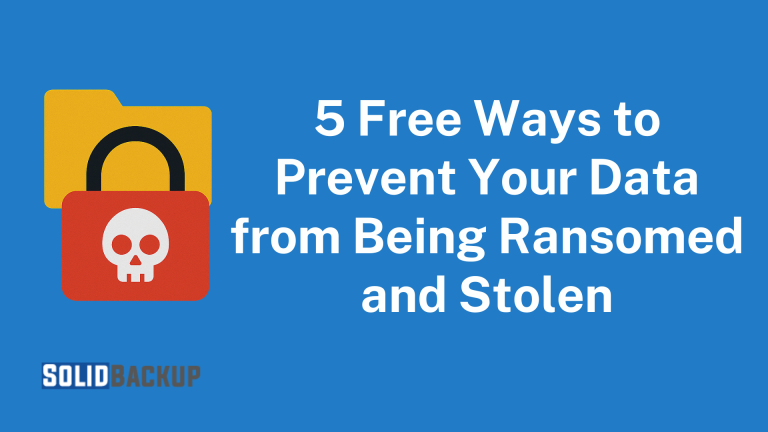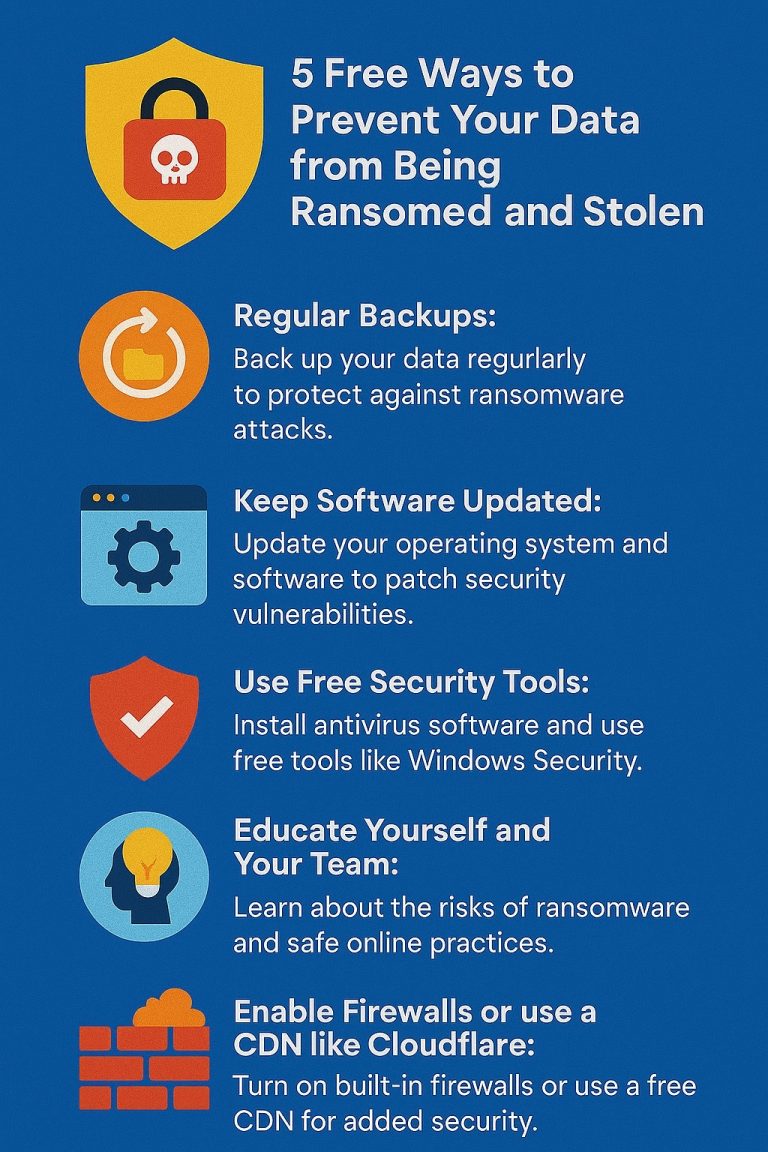
In 2025, ransomware and data theft will be growing threats targeting individuals and businesses. Cybercriminals can lock your files or steal sensitive information, demanding payment to restore access. Losing precious photos, work documents, or customer data can be devastating, but you don’t need expensive tools to protect yourself. This article shares five free ways to safeguard your data from ransomware and theft.
Why Protect Your Data from Ransomware and Theft?
Ransomware encrypts your files, making them inaccessible until you pay a ransom, often in cryptocurrency. Data theft involves hackers stealing personal or business information, like passwords or financial details, for fraud or resale. In 2025, ransomware attacks are more sophisticated, exploiting software vulnerabilities or phishing scams. The good news? You can reduce these risks without spending a penny. Let’s explore five free methods to keep your data safe.

1. Regular Backups
Backups create copies of your data, ensuring you can restore files if ransomware locks them or thieves delete them. Regular backups are your first line of defence, and you are free with the right approach.
- How to Do It: Use built-in tools like Windows Backup and Restore or macOS Time Machine to save files to an external hard drive or USB stick. Disconnect the drive after backing up to protect it from ransomware. For cloud options, use free tiers of services like Google Drive (15GB) or Mega (20GB) to store critical files.
- Why It Works: If ransomware strikes, you can wipe your device and restore files from your backup, avoiding the ransom. Backups also recover stolen or deleted data.
- Tips: Back up weekly or daily for frequently changed files. Follow the 3-2-1 rule: three copies, two different media, one off-site (e.g., cloud or detached drive). Test restores to ensure backups work.
- Example: A student backs up their thesis to a USB drive weekly. When ransomware hits, it restores the file without paying.
Regular backups give you peace of mind, making ransomware less threatening by ensuring you never permanently lose access to your data.
2. Keep Software Updated
Outdated software is a common entry point for ransomware and hackers exploiting known vulnerabilities. Keep your software updated, patch these gaps, and make it completely free.
- How to Do It: Enable automatic updates on your operating system (Windows, macOS, Linux), web browsers (Chrome, Firefox), and apps (e.g., Adobe Reader). Check for updates monthly if automatic isn’t an option. For mobile devices, update iOS or Android regularly.
- Why It Works: Updates fix security holes that cybercriminals target. For example, a 2025 Windows vulnerability allowed ransomware to spread, but a patch stopped it. Staying current reduces your risk.
- Tips: Restart devices after updates to ensure they apply. Avoid unofficial software, which may lack security patches. Use a free tool like Patch My PC to scan for outdated apps.
- Example: A small business updates its browser, blocking a phishing attack that exploits an old Chrome flaw.
Updating software is a quick, free way to close doors to ransomware and data theft, keeping your devices secure.
3. Use Free Security Tools
Free security tools, such as antivirus programs, anti-malware apps, and browser extensions, provide robust protection against ransomware and hackers without costing a penny.
- How to Do It: Install free antivirus software like Windows Defender (built into Windows 10/11), Avast Free Antivirus, or Bitdefender Antivirus Free. Use Malwarebytes Free to scan for and remove malware. Add browser extensions like uBlock Origin to block malicious ads or HTTPS Everywhere to enforce secure connections.
- Why It Works: Antivirus tools detect and block ransomware before it encrypts files. Malwarebytes removes spyware that steals data. Browser extensions prevent phishing sites from tricking you into sharing passwords.
- Tips: Run weekly scans with your antivirus. Keep tools updated for the latest threat detection. Avoid “free” tools from unknown sources, which may be malware in disguise.
- Example: A freelancer uses Windows Defender to stop a ransomware download from a fake email attachment, saving their project files.
Free security tools act like a digital shield, stopping threats before they can ransom or steal your data.
4. Educate Yourself and Your Team
Knowledge is a powerful, free weapon against cyber threats. Educating yourself and your team about ransomware and data theft helps you spot and avoid attacks.
- How to Do It: Learn to recognise phishing emails, which often deliver ransomware or steal login details. Look for red flags like misspellings, urgent demands, or suspicious links. Use free online resources like Google’s Phishing Quiz or StaySafeOnline.org. Train your team with free webinars from cybersecurity organisations like the UK’s National Cyber Security Centre (NCSC).
- Why It Works: Most ransomware attacks start with human error, like clicking a malicious link. Awareness reduces these mistakes. For businesses, trained employees lower the risk of breaches, which cost thousands. If ransomware does strike, find out how to recover your data in our article Can I Recover from Ransomware?
- Tips: Practice spotting fake emails weekly. Teach your team to verify requests for sensitive data (e.g., call to confirm). Use strong, unique passwords with a free manager like Bitwarden.
- Example: A shop owner avoids a phishing email asking for bank details by recognising its odd sender address and keeping customer data safe.
Education empowers you to outsmart cybercriminals, preventing data ransom or theft at no cost.
5. Enable Firewalls or Use a CDN Like Cloudflare
Firewalls and content delivery networks (CDNs) like Cloudflare are barriers that block unauthorised access to devices or websites. Many options are free and easy to set up.
- How to Do It: Enable your device’s built-in firewall (Windows Defender or macOS Firewall) to block suspicious connections. For websites or small businesses, use Cloudflare’s free plan, which includes a web application firewall (WAF) and DDoS protection. Install a free firewall app like ZoneAlarm Free Firewall for extra device protection.
- Why It Works: Firewalls stop ransomware from communicating with hackers’ servers, preventing encryption. Cloudflare blocks malicious traffic to your website, protecting customer data. Both reduce the risk of data theft by filtering out threats.
- Tips: Check firewall settings monthly to ensure they’re active. Use Cloudflare’s DNS (1.1.1.1) for faster, safer browsing. Avoid disabling firewalls, even temporarily.
- Example: A blogger uses Cloudflare’s free plan to block a ransomware bot targeting their site, keeping their content and visitor data secure.
Firewalls and CDNs provide free, adequate protection, stopping ransomware and thieves before they reach your data.
Additional Tips for 2025
To boost your protection:
- Use Multi-Factor Authentication (MFA): Enable MFA on free services like Gmail or Dropbox to add a security layer, preventing unauthorised access.
- Limit File Sharing: Avoid public Wi-Fi for sensitive tasks and use free VPNs like ProtonVPN’s basic plan for secure connections.
- Monitor Accounts: Check bank or email accounts regularly for suspicious activity, using free alerts from your bank or provider.
Conclusion
Ransomware and data theft are serious risks in 2025, but you can protect your data without spending a penny. Regular backups save your files, updated software closes vulnerabilities, free security tools block threats, education helps you avoid scams, and firewalls or CDNs like Cloudflare stop attacks. These five free methods empower you to safeguard personal photos, work projects, or business records. Start implementing them today to keep cybercriminals at bay and your data secure. Stay vigilant, and enjoy peace of mind knowing your digital life is protected!



